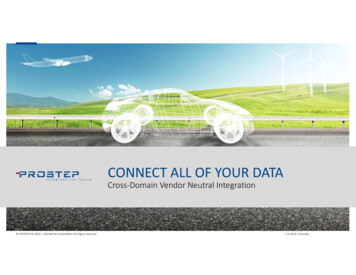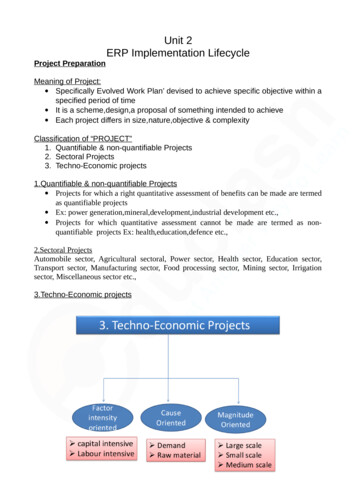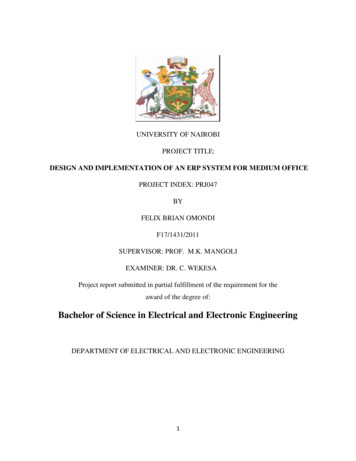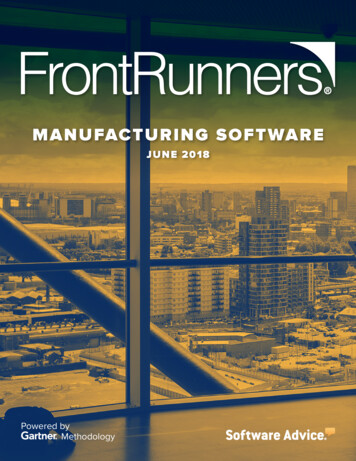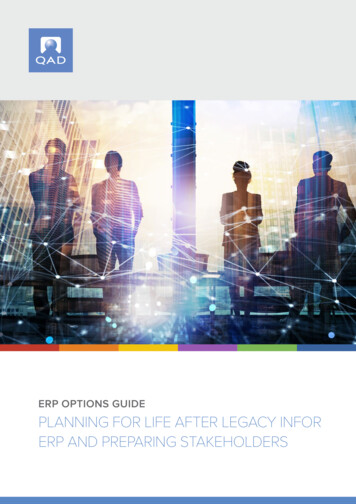
Transcription
ERP OPTIONS GUIDEPLANNING FOR LIFE AFTER LEGACY INFORERP AND PREPARING STAKEHOLDERS
CONTENTSTime to Move On from Outdated Infor ERP Acquisitions? 3Modernise ERP Capabilities4Next Generation ERP Delivers Benefits5Checklist Considerations6Prepare the Business Case8Summary 9
TIME TO MOVE ON FROM OUTDATED INFORERP ACQUISITIONS?Like many Infor customers, you may be reviewing your options as a result of Infor’s outdated ERPacquisitions including Baan, Fourth Shift, Mapics, JBA, BPCS, Lawson, TRANS4M and others . As youconsider whether to stay the course with Infor or migrate to a modern enterprise resource planning(ERP) solution, we have compiled relevant information for selecting a next generation ERP solution.This includes concepts to fully understand modern ERP capabilities and the resulting benefits withinan organisation; how to influence stakeholders; how to build a business case; how to select the rightpartner and much more. This is a convenient guide to help you navigate the path to bring a world classERP solution into your organisation and ultimately, behavioral change resulting in improved outcomesfor individuals and the organisation.Educate yourself, share with others in your organisation and lead them to an informed decision.If you can initiate change and garner purchase agreement; if you are responsible for researching,purchasing and/or influencing colleagues on an effective and beneficial ERP solution, this is for you.Specifically, if you are a decision maker or influencer working in departments such as IT, procurement,finance, supply chain, or customer management and are seeking a proven next generation ERPsolution to drive business impact in your department or organisation, this is for you. You may besomeone who is trying to scale effective business processes across a global organisation, boostproduction efficiency, cut international supply chain costs or want to affect the top/bottom line of yourorganisation with advanced technologies.
MODERNISE ERP CAPABILITIESWith manufacturers requiring more advanced and digital technology to boost competitiveness andinnovation, you might be more aware of telltale signs that your legacy Infor ERP is not keeping up withthe pace of change in your industry. The signs include mounting costs, outdated technology, slowresponse to new business models, lack of scalability and other factors. ERP migration is not an easydecision but now is the time to progress digital capabilities. At a minimum, you should consider thefollowing for a comprehensive and adaptive ERP solution:CLOUD ERPADVANCED TECHNOLOGIESManufacturers need ERP and supply chain solutionsto rapidly deploy, scale and extend withoutsacrificing security and dependability. They alsowant to simplify the implementation, upgrading andongoing management of their ERP. This frees up ITresources to focus on strategic initiatives and rapidlyprovide ERP regardless of the language or country.Manufacturers face an increasingly competitiveenvironment and must increase productivity, runmore efficient supply chains and deliver higherquality products that delight customers, increasesustainability and improve profitability. Digitaltransformation, which requires more advanced andinnovative technology, is a key initiative to helpmanufacturers succeed in this challenging businessenvironment.MODERN USER EXPERIENCEApplications with a brittle user experience makeit difficult for manufacturers to onboard newusers or support changing user roles. To keepcritical information solutions like ERP and supplychain management working effectively, the userexperience must adapt to each users’ preferredwork style and device and foster collaborationacross all business processes. Today’s workforceexpects an intuitive user experience.ADAPTIVE PLATFORMChanges in the business environment and inthe way products are manufactured impact amanufacturer’s tactics, as well as any relatedbusiness processes. The ability of the ERP solutionto respond to change, to deliver fit over time andcontinue to support new business processes, willdetermine its effectiveness.INDUSTRY BEST PRACTICESManufacturers need adaptive ERP solutions thatcombine proven industry best practices withthe ability to rapidly adapt to changing businesschallenges.A SOLID PLAN MAKES ALL THEDIFFERENCENow is the time to plan your next ERPimplementation, particularly if you are amulti-location, multinational enterprise.Enterprise application consultant MintJutras, in an exclusive report, offers guidanceon preparing your business for the futurewhen faced with end-of-life technology.See the report here
NEXT GENERATION ERP DELIVERS BENEFITSThe accelerating pace of change creates risks and opportunities in the markets manufacturers serve and theway in which they manufacture. The changes include, but are not limited to, geopolitical instability, changingbusiness models, cybersecurity concerns, digitally connected products and increasing customer demands.In this environment, manufacturers simply cannot rely on an outdated, acquired Infor ERP system toeffectively support critical business applications. Additionally, legacy ERP systems cannot keep up withadvanced digital capabilities including IoT, mobility, advanced analytics, robotic process automation, datalakes, digital twins and the list goes on.Key business drivers for next generation ERPsystems include: Simplify implementation, upgrading and ongoingERP system management Improve efficiency and user productivity Reduce security and corporate risks Effectively support digital technologies andfuture advanced technologies Gain real-time business insight for betterdecision-making Quickly extend applications to meet changingbusiness priorities and processesCLOUD ERP DELIVERS ROIImperial Tobacco shifted its existingproduction environment to the cloudrather than upgrading and refreshingits on-premise infrastructure, reducingits project costs by over 7 million. Thecompany was able to reduce its costsrelated to maintenance, developmentand technical staff, and technology hosting.Access the report here
ERP CHECKLISTTECHNOLOGY CONSIDERATIONS:Infrastructure: Select a cloud-based solution thatprovides the security, scalability and reliabilityrequired. Extensive cybersecurity certifications Full disaster recoveryPlatform: Modular architecture allowing for smaller,targeted upgrades Extension support to survive upgrades withoutre-testing or reimplementation Low, no code app development Ability to personalise without programming skills RESTful API architecture to easily extend andbuild new apps Agility to rapidly respond to new businessconditions and incorporate advancedtechnologies like IoT, machine learning, artificialintelligence, data lake and othersIntegration capabilities: The ability to integrate withother enterprise systems and trading partners isimperative for a cost-effective deployment. System integration Trading partner integration (timely access toinformation from customers, suppliers, carriers,customs brokers and other trading partners)Reporting: Users should have access to flexiblereporting tools for comprehensively managingand analysing operational processes across thebusiness. Embedded analytics and self-service reportingLocalised user interface: Multiple geographiesmeans a need for a platform supporting multiplelanguages.Built for your business: Embedded manufacturing industry features andbest practices Business process monitoring and management Ability to meet unique last mile needs thatdifferentiate your business Adaptable and modern user experience (easynavigation, visual appearance, personalisation) Rapid deployment for quick time to benefit
SUGGESTED CHECKLIST FOR SOFTWARE SERVICES:Scope of customer service and support: Understandwhich services are included as part of the license andwhich require an additional fee.Integration support: If you need to integrate withother systems, is someone available to help? Howmuch experience does the provider have regardingintegration? Are these services included or anadditional fee?Training: What product training and other resourcesare available? Is the product documentationcomprehensive? Are there live SMEs that you cancontact for product-related questions?Implementation services: What resources andexpertise will help in deploying your program? Does theprovider have an implementation methodology? Howlong do the provider’s implementations typically take? Onboarding methodology based on industry bestpractices Extended services that support unique businessneeds delivered by custom and tailored solutionsData Migration: What support is available formigrating data from legacy systems to the target ERPsystem? What data migration strategies, processesand tools are available?Test Scripts: What standard test scripts are available?Are these industry based? Is there an extra cost fortest scripts?Implementation timeline: How rapidly can the firstand future “go live” event(s) occur? Seven years Five years Three years One year Six monthsConsulting services: What services are available tohelp align the ERP system with your operations andensure improved performance?
PREPARE THE BUSINESS CASESTEP 1: DEFINE THE BUSINESS ISSUESSTEP 3: CREATE THE BUSINESS CASEIdentify the business opportunity and issues to besolved: After analysing the alternatives, prepare thewritten business case Create a succinct description The objectives should align with organisationalgoals and senior management prioritiesRely on a template with a simple and soundstructure: An example might be “reduce operatingexpenses” or “decrease corporate risk”Develop an opportunity statement:ˉExecutive SummaryˉCurrent situationˉAnalysis & RecommendationˉConclusion This describes the benefitsSTEP 4: PRESENT THE BUSINESS CASE For example, “reduce international supply chaincosts while improving product availability” Rehearse your persuasion and influencing skills Select the time, place and approach that bestsuits the stakeholders Keep your presentation focused and concise Be prepared to deal with questions that mayarise:STEP 2: ANALYSE ALTERNATIVES AND SELECTTHE BEST OPTION Identify and collect information on possiblealternatives Research case studies of companies that havefaced similar challengesˉHave you ever implemented a similar ERPsolution? Weigh alternatives against one another infinancial terms, intangible benefits and risk levelˉWhat else might be needed that is notidentified in the business case? For the financial terms, a payback period and ROIanalysis are common toolsˉWhat assumptions have you made that yourstakeholder may disagree with? Payback period illustrates how long it will take torecover the initial investment ROI shows the monetary impact your investmentis predicted to yield
SUMMARYAn agile and effective ERP solution can greatly improve business outcomes for supply chain, production,customer management, finance and other objectives. Too often, companies are making what they consider tobe a “safe choice” with big ERP providers like Infor rather than fully understanding what a manufacturing ERPsystem needs to deliver their organisation. It’s imperative that manufacturers consider and select enterprisesystems that eliminate the need for costly customisations, adapt to the rapid pace of business change andeffectively address future technologies.QADQAD Inc. (Nasdaq: QADA) (Nasdaq: QADB) is a leading provider offlexible, cloud-based enterprise software and services for globalmanufacturing companies.QAD Cloud ERP for manufacturingsupports operational requirements in the areas of financials, customermanagement, supply chain, manufacturing, service and support,analytics, business process management and integration. QAD’sportfolio includes related solutions for quality management software,supply chain management software, transportation managementsoftware and B2B interoperability. Since 1979, QAD solutions haveenabled customers in the automotive, consumer products, foodand beverage, high tech, industrial manufacturing, and life sciencesindustries to better align operations with their strategic goals tobecome Effective Enterprises.For more information, please visit www.qad.com,or call 44 121 506 6500
Copyright 2020 QAD. All rights reserved. The word and design marks set forth herein are trademarks and/or registeredtrademarks of QAD and/or related affiliates and subsidiaries. All other trademarks listed herein are the property of theirrespective owners.www.qad.comQAD Europe Ltd, Sir Stanley Clarke House, 7 Ridgeway, Quinton Business Park, Birmingham, West Midlands, UK, B32 1AF
TIME TO MOVE ON FROM OUTDATED INFOR ERP ACQUISITIONS? Like many Infor customers, you may be reviewing your options as a result of Infor's outdated ERP acquisitions including Baan, Fourth Shift, Mapics, JBA, BPCS, Lawson, TRANS4M and others . As you consider whether to stay the course with Infor or migrate to a modern enterprise resource planning
